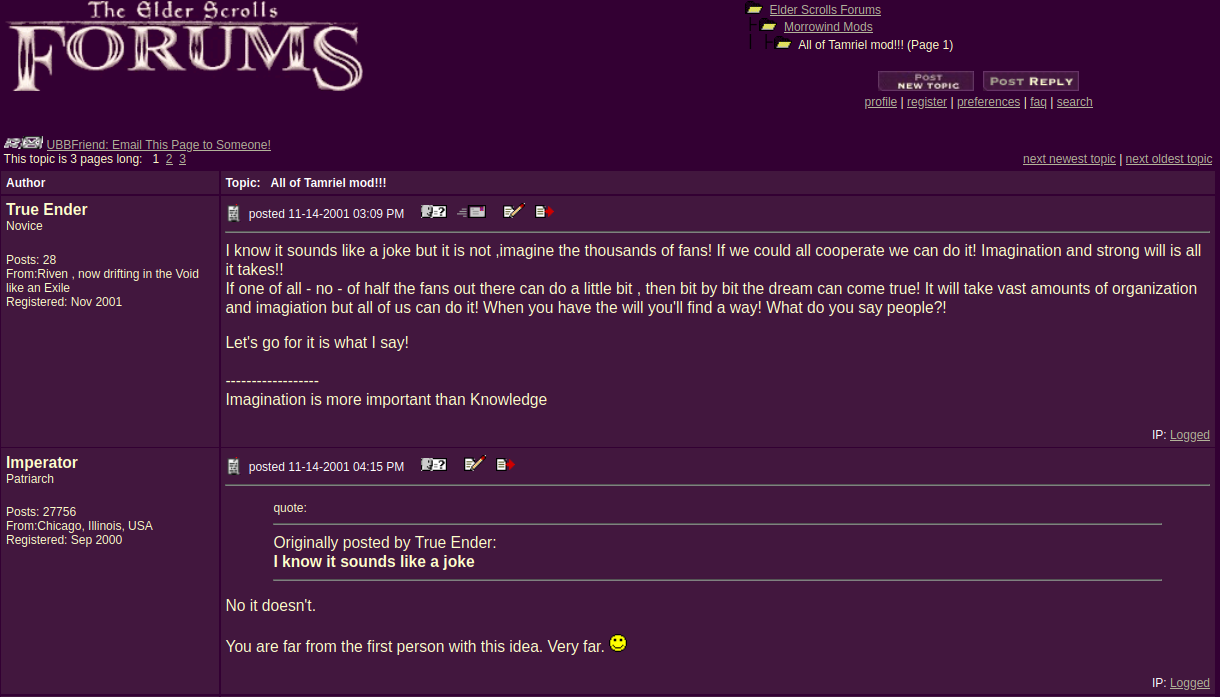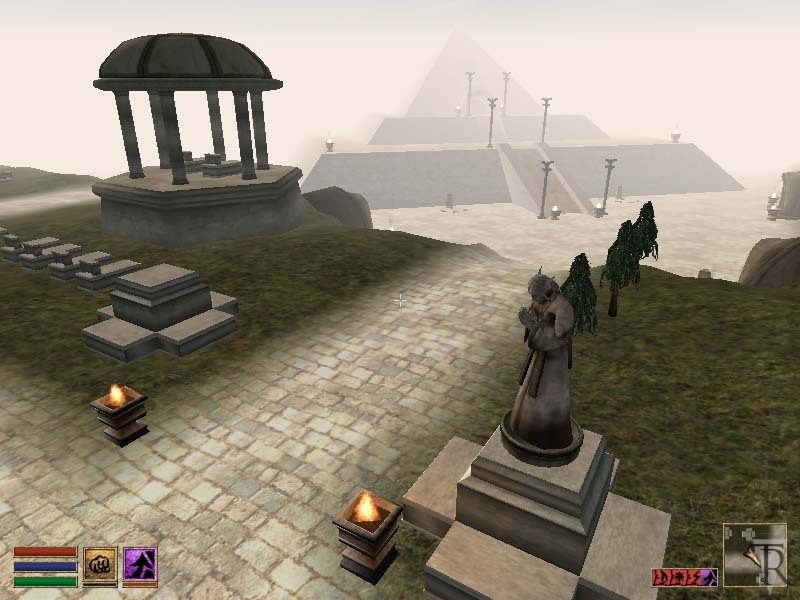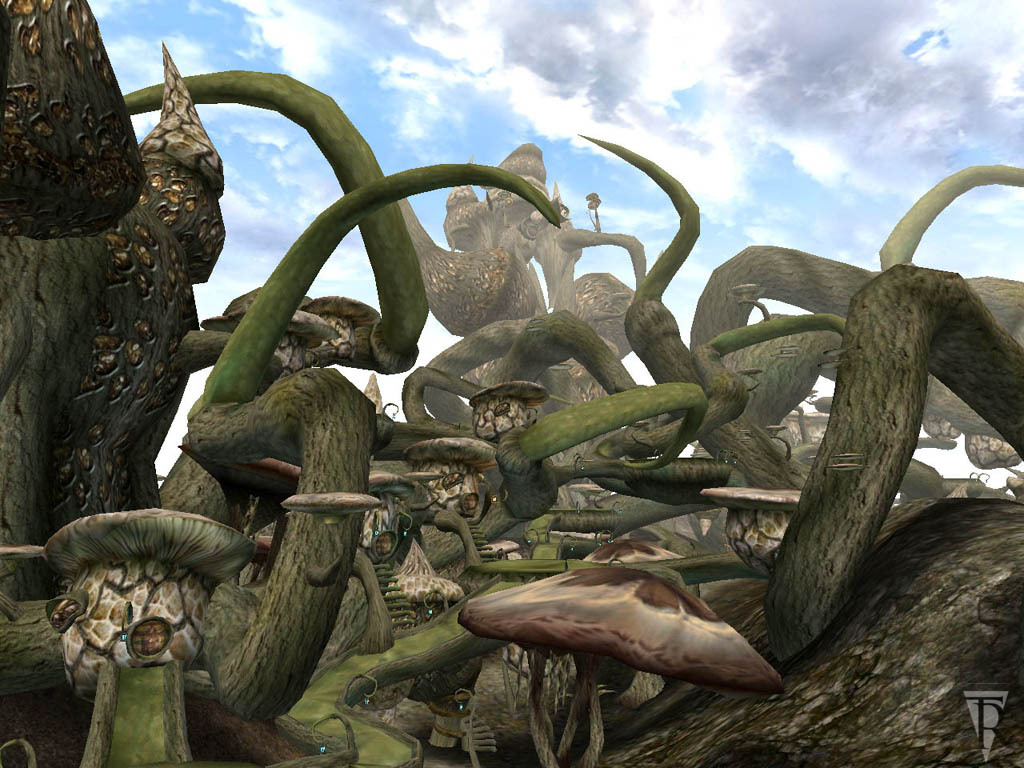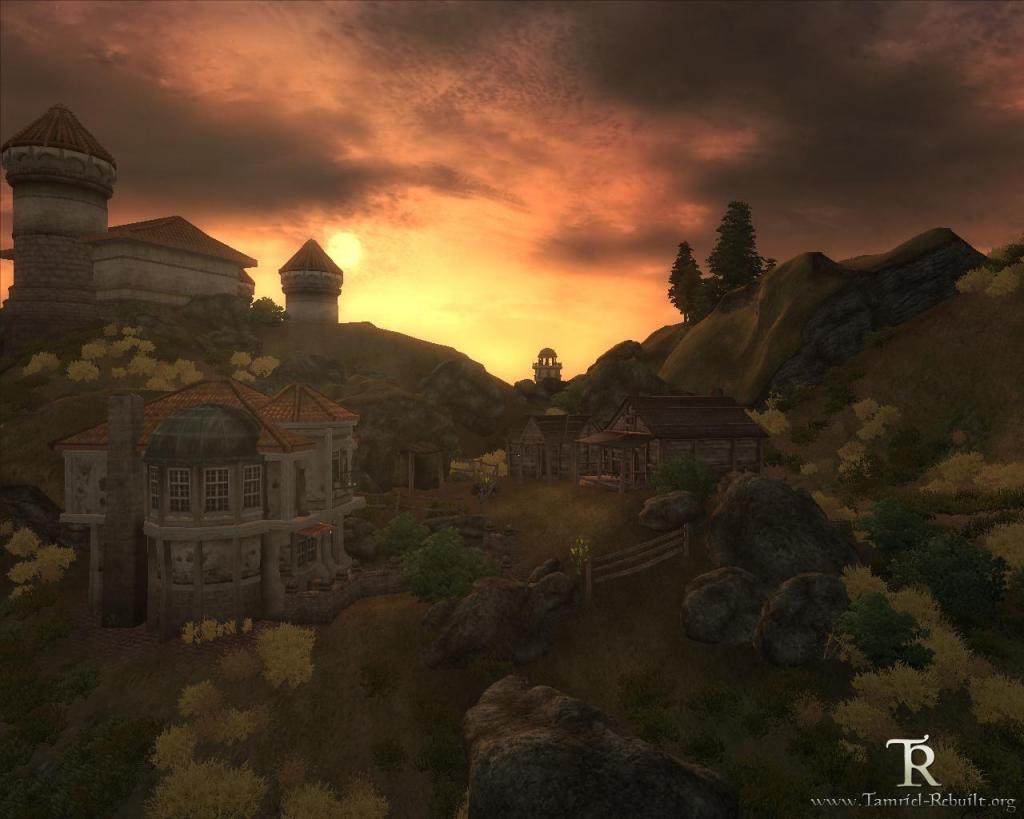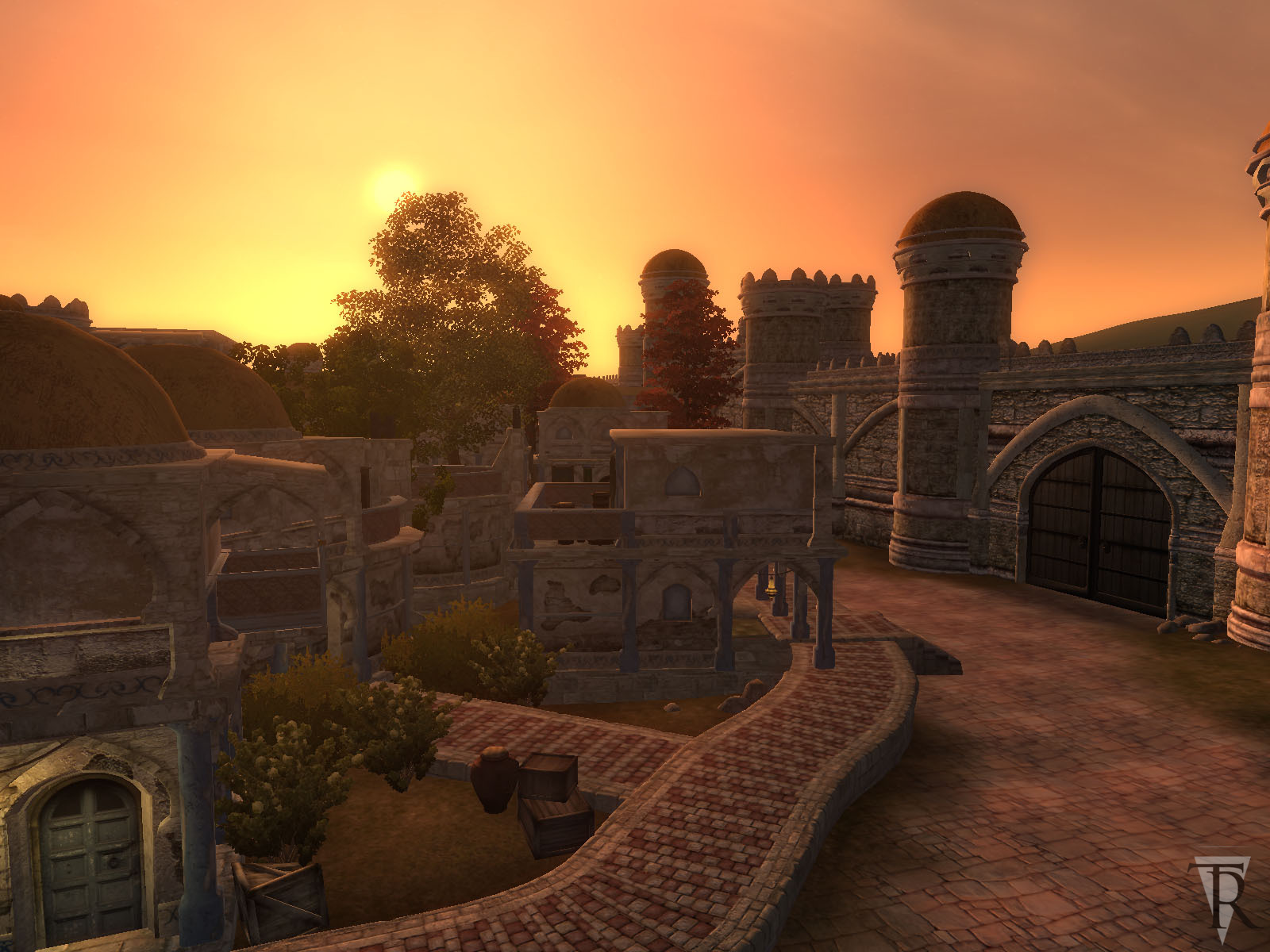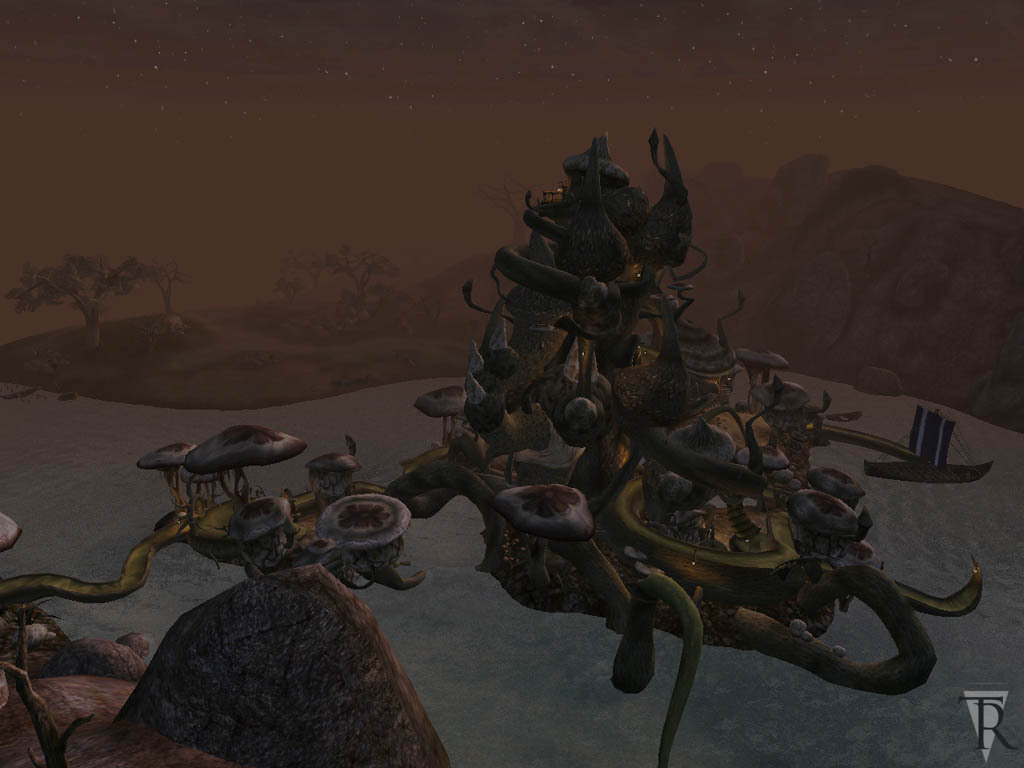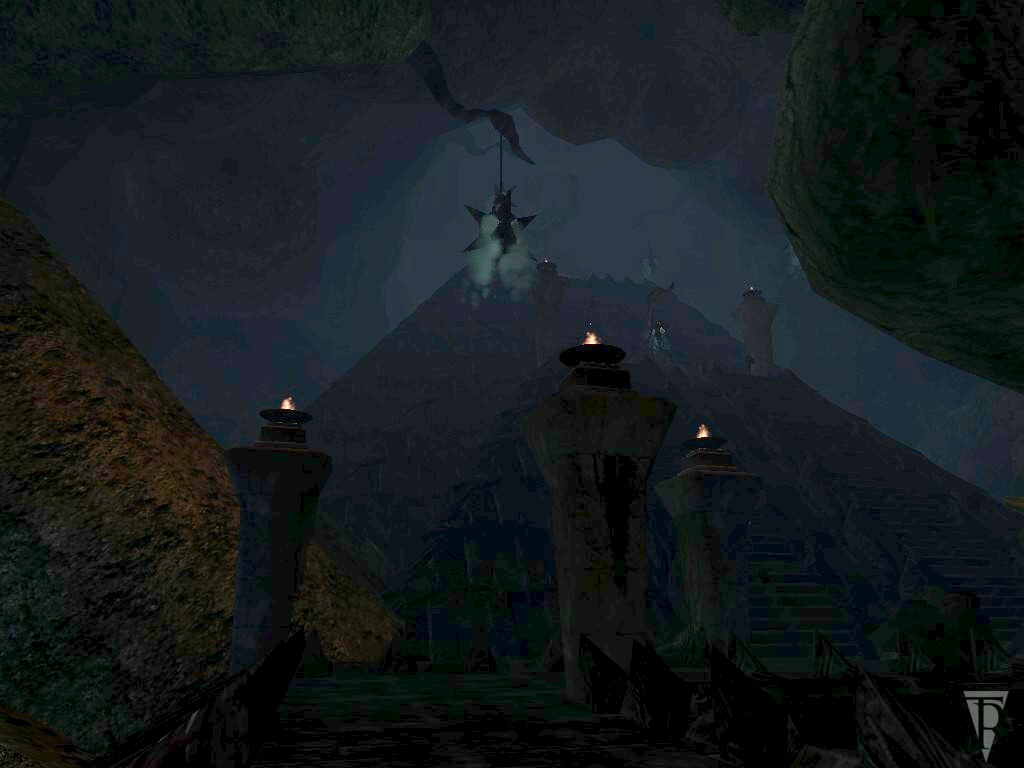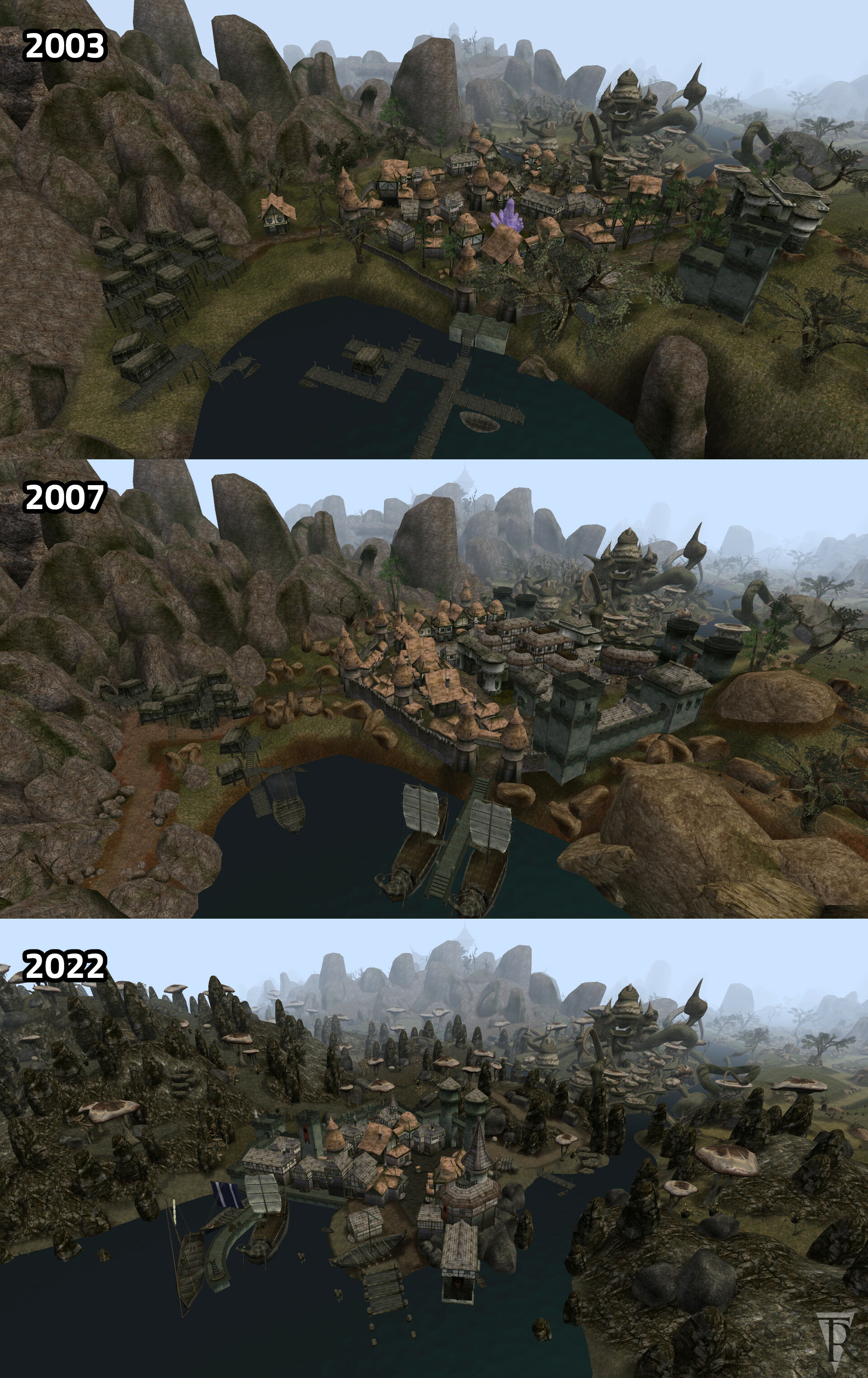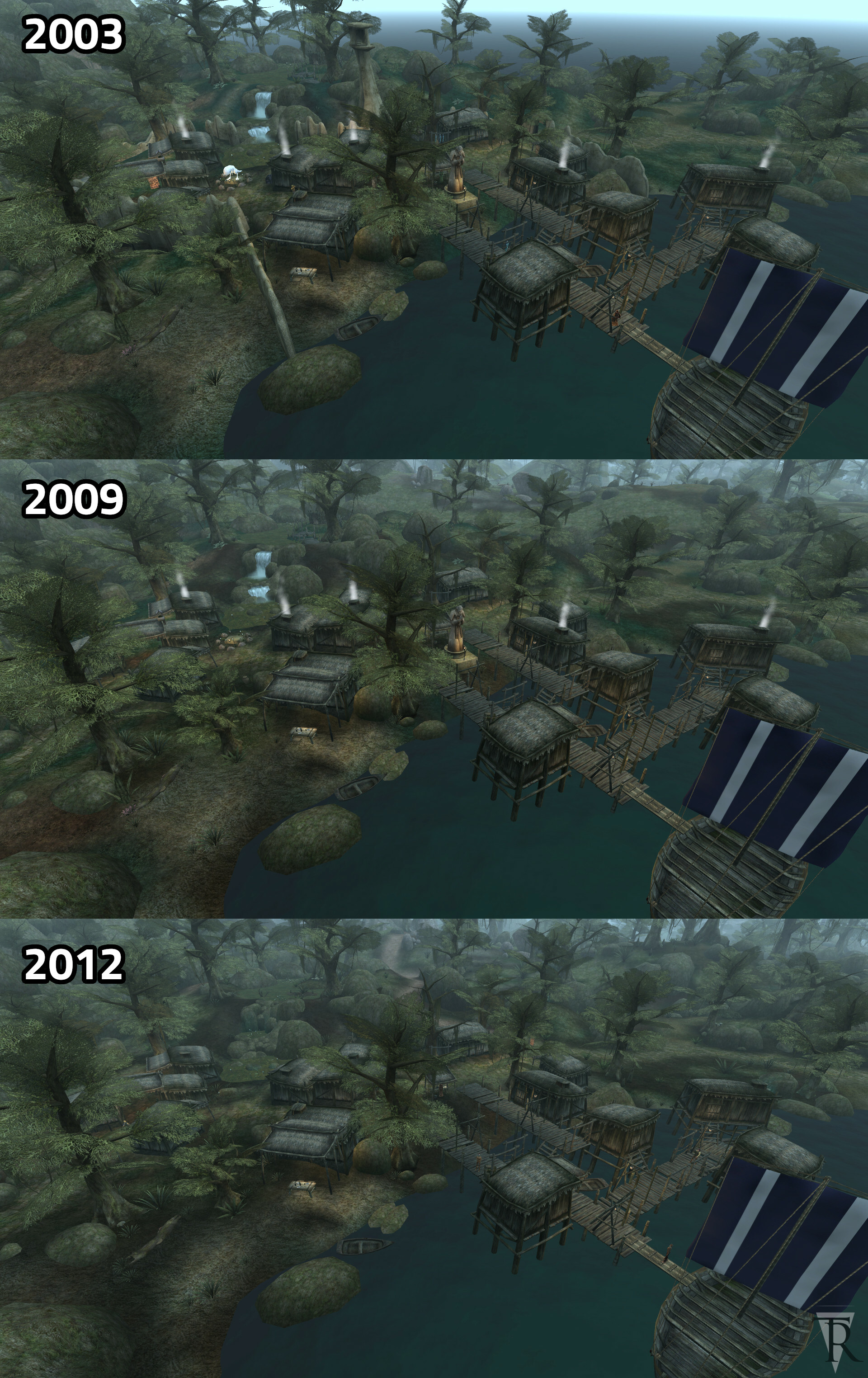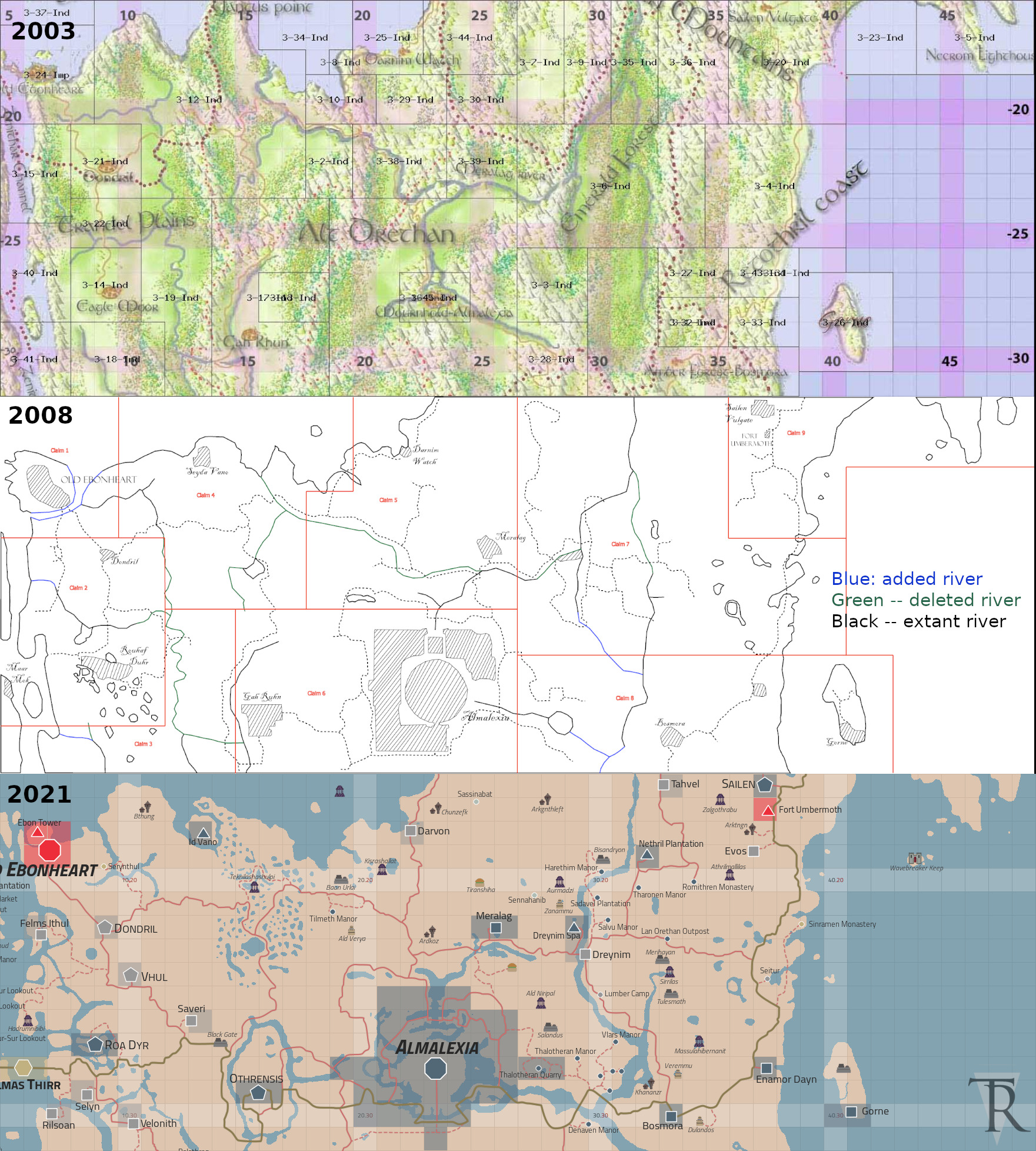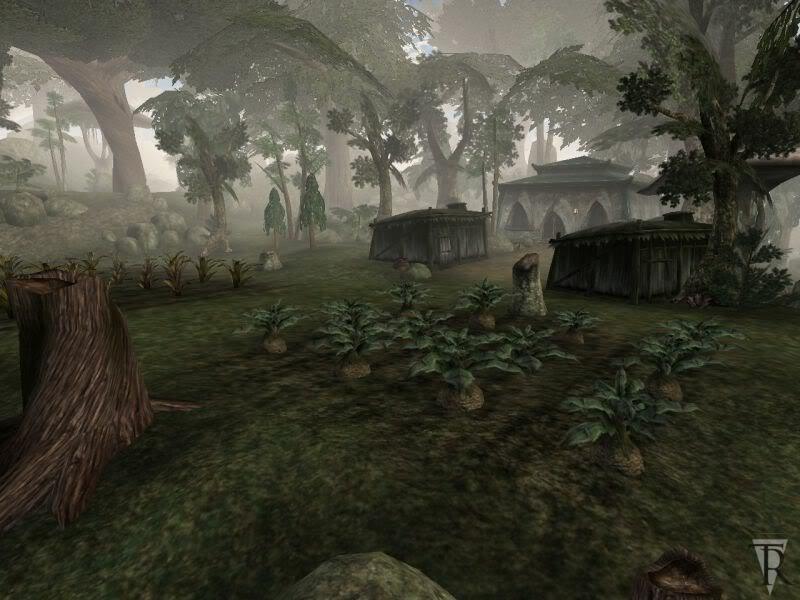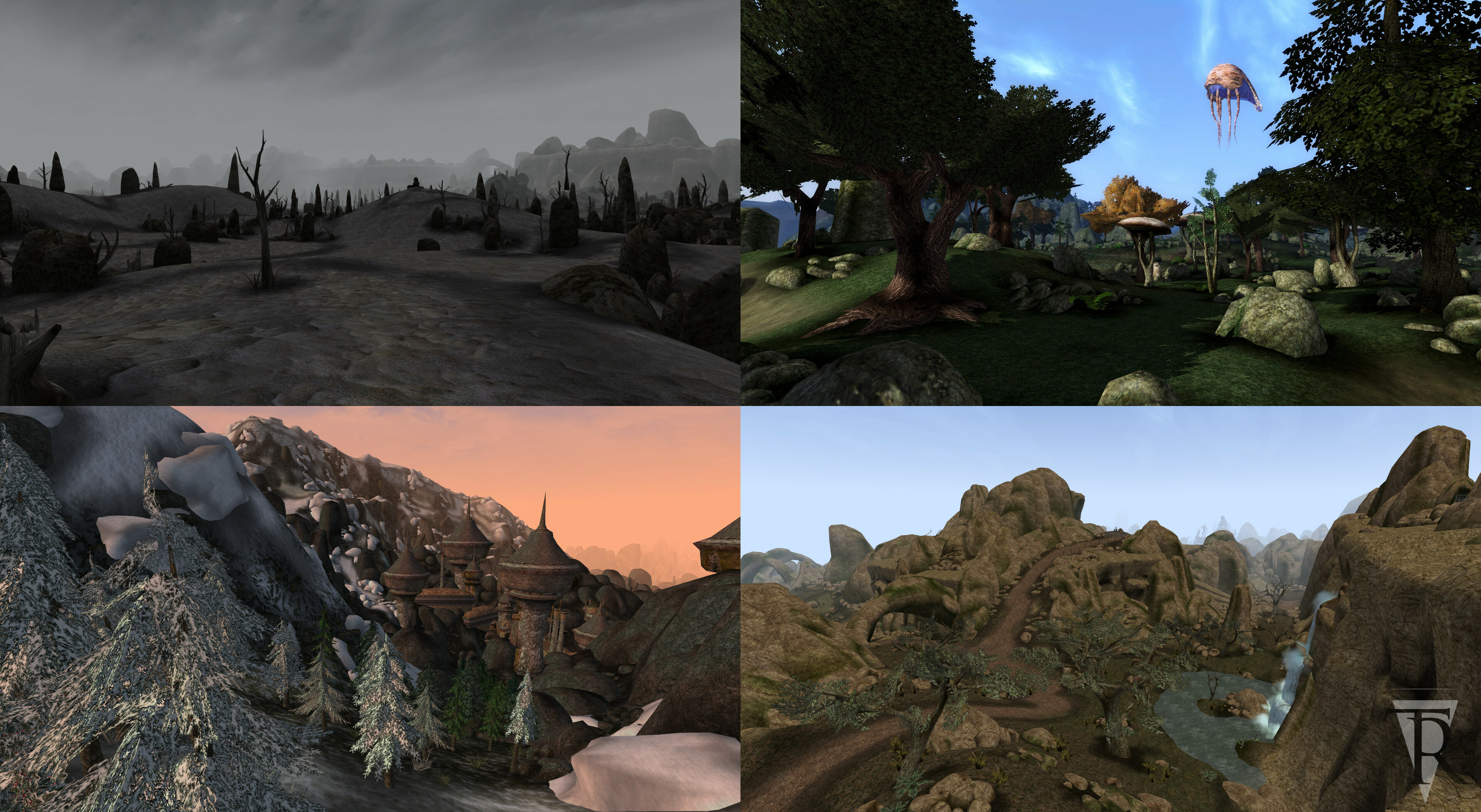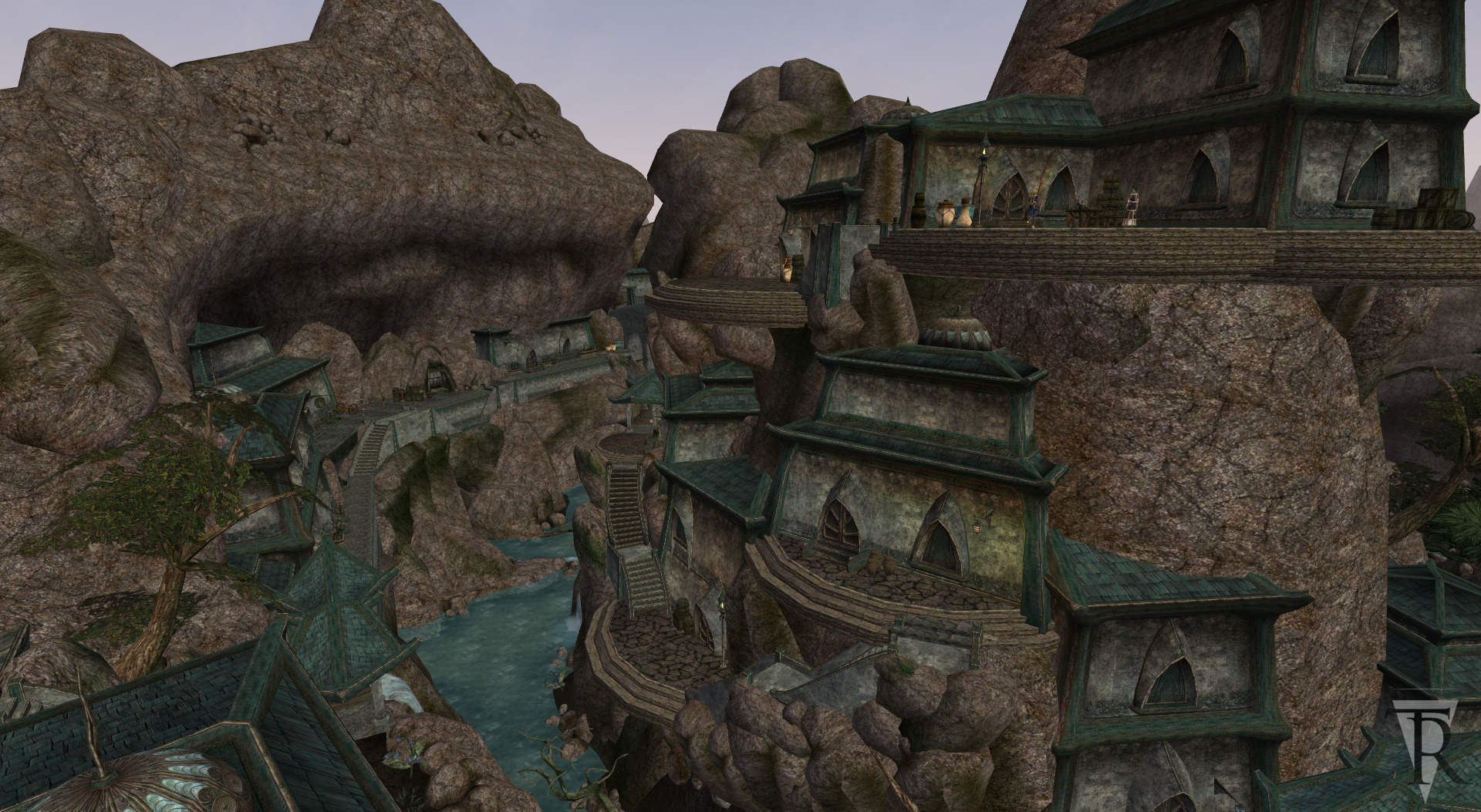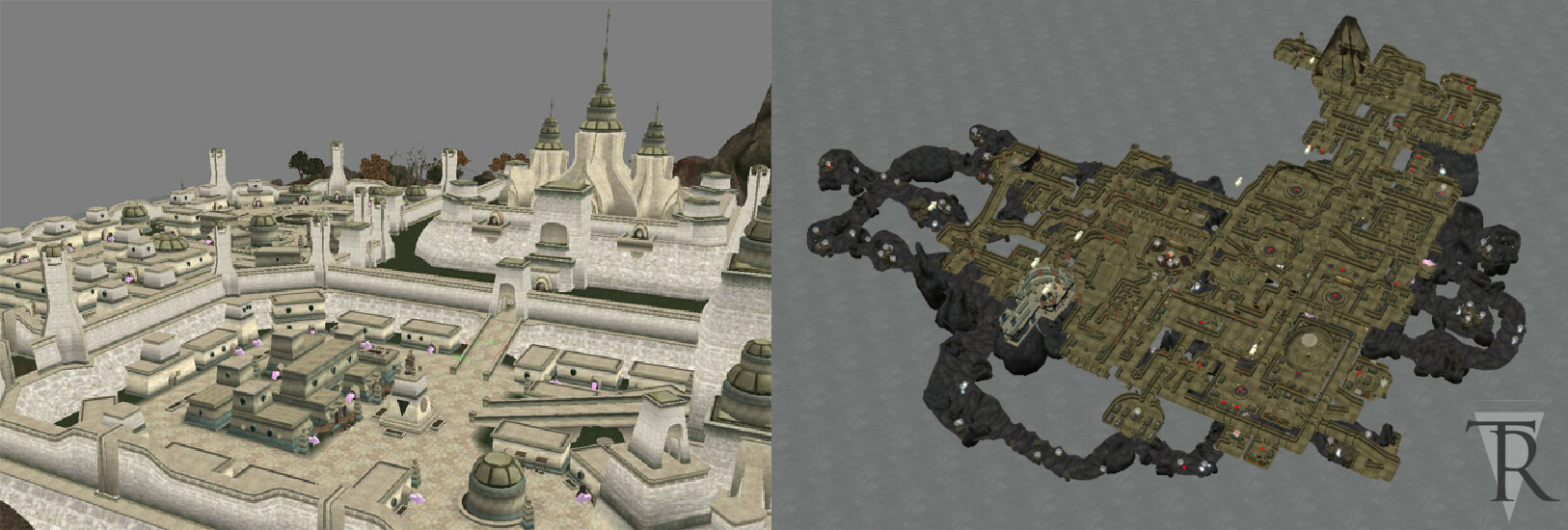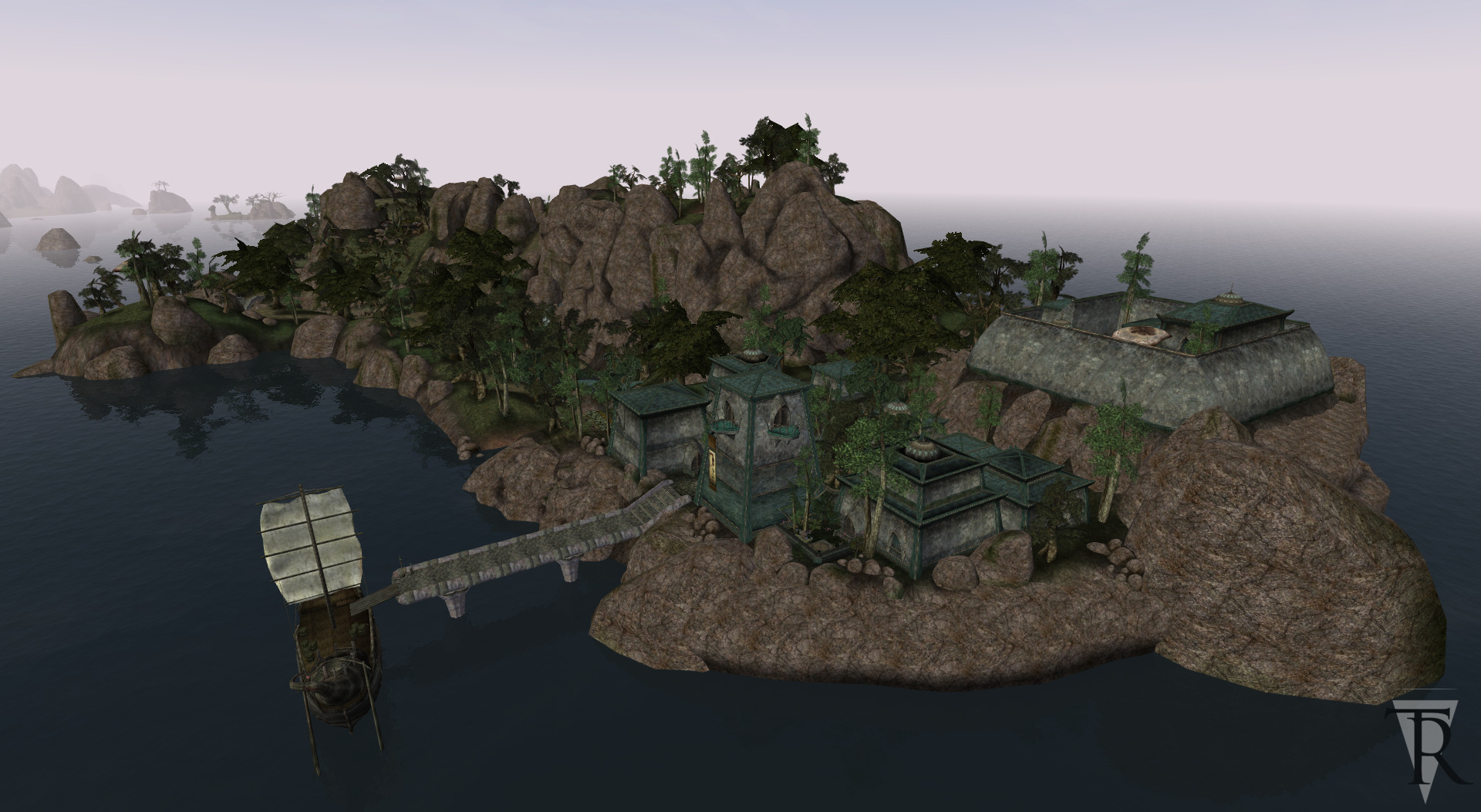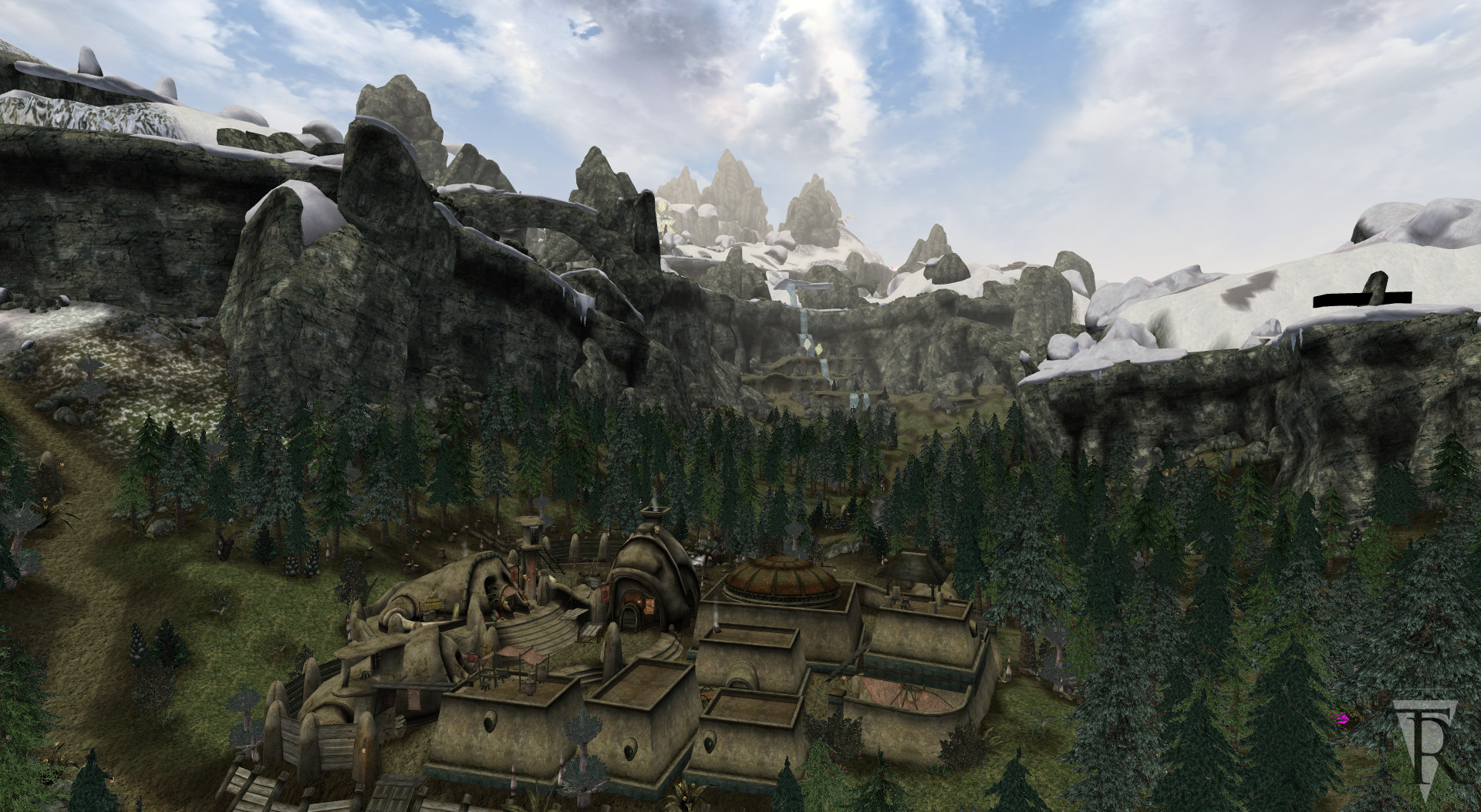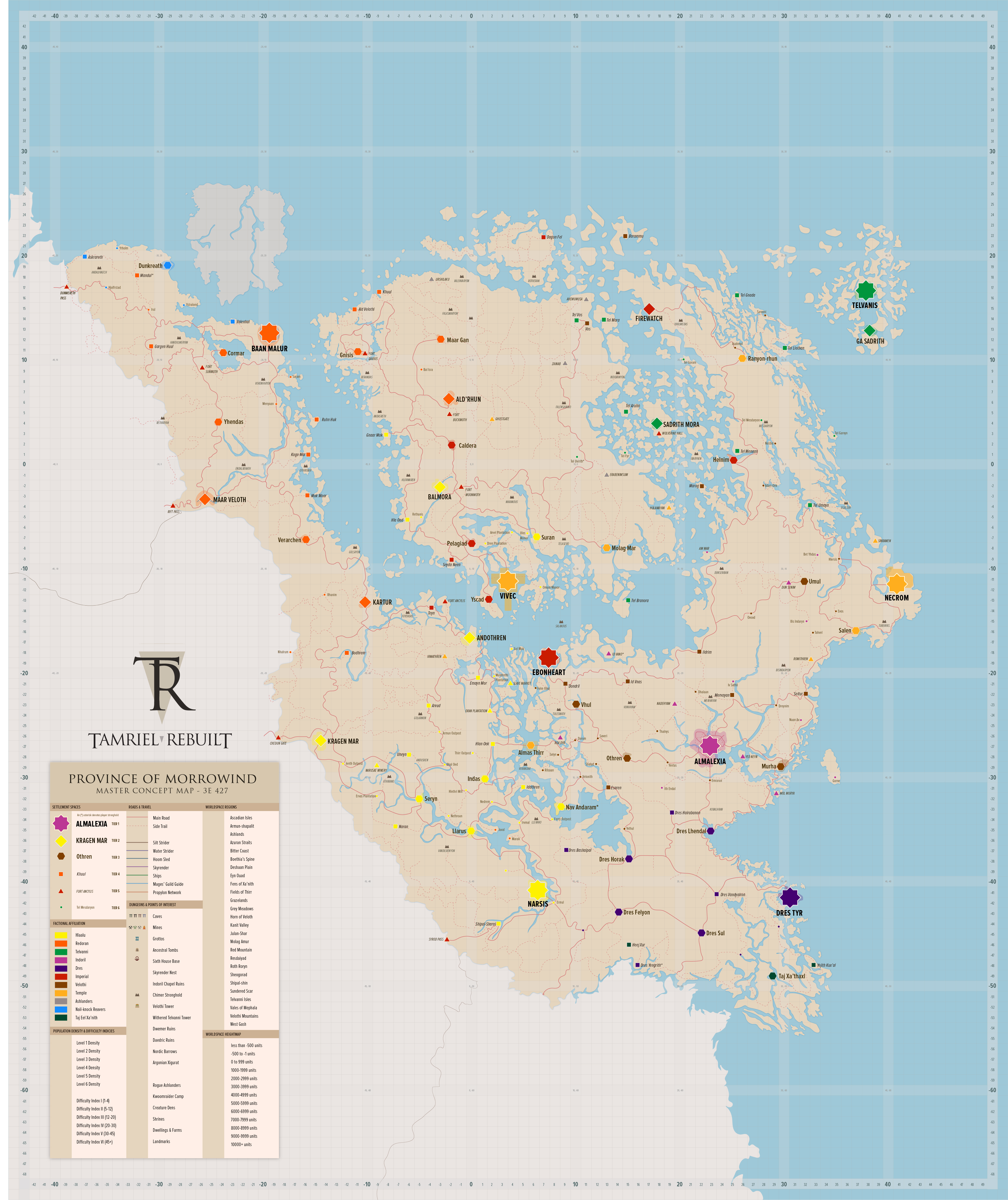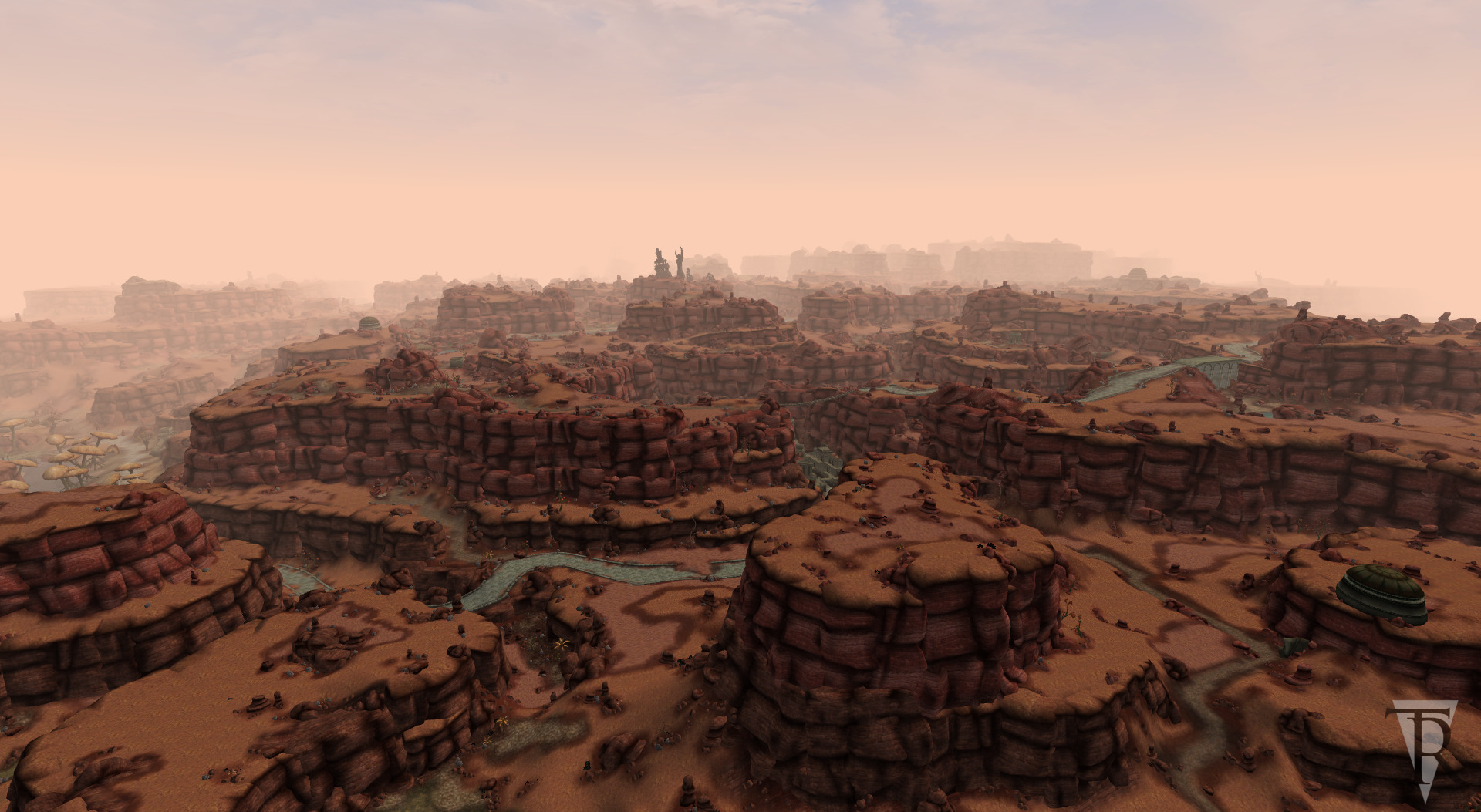An ancient, 2004 trailer for Tamriel Rebuilt by Prometheus, featuring theme music by Dragonfly.
Tamriel Rebuilt has been a prominent part of the Morrowind modding community since its inception, which stretches back even before the game was released. In fact, parts of TR are likely some of the oldest Morrowind mod content still actively being played.
The mod’s history can be divided into several eras, each with their own distinct character, closely mirroring that of the wider modding community. You will see that this history was often filled with over-the-top modder drama, innumerable setbacks and content re-dos; the fate of the continued endeavor often hung in the balance. Yet, each era has also been characterized by slowly upwards-creeping quality of content, built brick by brick through the trial and error of countless modders of yesteryear.
Released areas of Morrowind province covered by Bethesda’s and Tamriel Rebuilt’s expansions are marked by clear or blue areas and years of initial release. Future in-progress expansions are marked by shaded areas and green italic text. Planned reworks of older areas are marked in red.
The context within which the earlier parts of the mod were developed not only helps us understand its quirks and oddities, but also allows us to better appreciate each part of the mod, by connecting us to the people and times that they represent.
The Beginnings: 2001-2005
The original forum post that started it all. While there was some enthusiasm for the idea, most people were skeptical, perhaps rightly so.
The birthday of Tamriel Rebuilt is the 14th of November, 2001, when a modder called Ender brought up a crazy idea on the old Elder Scrolls Forums. In Summer 2001, it had become clear that TES III would be cut down to only the island of Vvardenfell, but that the development tools used to craft the game would be released along with it. Disappointed to not be receiving the whole of Morrowind, different enthusiasts attempted to organize communities that would build out the rest of province in the months preceding Morrowind’s release. Ender was only one of these people, but his naive idea was the only one to survive. The chosen approach was to crowd-source the creation of not only the remaining part of Morrowind, but eventually the entirety of Tamriel by a loose-knit network of independent modders – a potentially endless TES III experience. Facing overwhelming skepticism, a small core of enthusiasts were, nevertheless, willing to prove everyone wrong.
Moorkh created TR’s old planning map in Summer 2002 to coordinate the first land claims. It was later discovered that Bethesda’s Vvardenfell paper map (in the middle) was wrongly projected, meaning that the Inner Sea ended up much narrower than intended.
As planned, TR initially acted as a consortium of largely autonomous modders that merely used a land claim framework to avoid stepping on each others toes. Famous early projects under TR’s umbrella included Ranyon-Ruhn by Acheron, Valderon’s Silgrad Tower, Rodan’s Blacklight, Secrets of Firewatch by the M.A.G.E.S. team, Veet’s Necrom, Ben Vagara’s Velothi Mountains and many others.
The mid-2002 Ranyon-Rhun by Acheron sits on a mesa overlooking the Molagreahd region (now the Sunad Mora region). This was the first ever land claim for TR, started barely a week after Morrowind’s initial release. Quests and dialogue were added later by El Scumbago.
Starting in 2003, however, a more centrally-directed claims system was instituted, the core team grew more discerning in their taste and interventions in individual modders’ work became more and more common. Hand-wringing about the “slow pace” of TR was common even in these earliest years, but in reality the huge size and naive enthusiasm of the Morrowind community resulted in fast gains. By 2005, almost all of Morrowind’s landscapes were ether complete or being worked on, and the same could be said for most interiors on the northeastern Telvannis peninsula – a mind-boggling feat compared to the much more ponderous pace of modern TR development. The landscape that was crafted in these heady days is still largely visible in the north-eastern parts of TR’s released lands and, in fragments, elsewhere.
Veet’s 2003 Necrom was hugely impressive for its time, thanks to its use of an entirely new architecture set. Although the layout of the city was completely changed in 2008 by Sload and Swiftoak, the meshes and aesthetic found their way into the public release in 2012.
Hundreds of people worked on TR in these early years, but there was always a cadre of superstar modders, whose stamp on the mod remains prominent to this day. One of these was Rodan, creator of TR’s first iteration of the city of Blacklight and a rather iron-fisted administrator who held the ship together through most of 2003 and 2004, especially after Ender left. Noirgrim, an extremely dedicated exterior modder, slaved away for years to create a frankly absurd portion of TR’s exteriors. Although most of his work in southern and western Morrowind has by now been redone, you can still see his original exteriors in Firewatch and other parts of Telvannis and in Sundered Scar (though many of these rather cookie-cutter exteriors are slated to be redone soon). Prometheus, another prolific exterior modder, created some of early TR’s most famous setpiece locations, such as Hendor Stardumz, Dun Akafell, Dragon’s Nest Inn, Riverbridge, Dunmeth Pass and Narsis. Screenshots from these claims attracted many new modders to join TR for a decade afterwards. Yinnie was a famous and beloved interior designer, reviewer and a heart of the community who, together with Kothloth, instituted some of TR’s first quality standards. Finally, Starcrunch, in between their work on interiors, wrote and coordinated many of TR’s first lore and quests.
The magnificent city of Narsis was Prometheus’ ultimate and most ambitious claim. Although its size and overuse of poorly-optimized meshes rendered it unplayable, all newer TR reinterpretations of this city have tried to capture its look.
Despite the frantic progress, the years between 2002 and 2005 were also a time of interminable soul-searching, intra-project rifts and various other drama, driven by increasing demands for quality as the first TES modders slowly honed their craft. The most traumatic of these was undoubtedly the split with Silgrad Tower – Valderon’s ever expanding mod, first having joined with TR in Fall 2002, that included large areas of north-western Morrowind.
Noirgrim completed more than 700 exterior cells during his time at Tamriel Rebuilt (for comparison, vanilla Morrowind has 790 exteriors cells). Here is his early 2003 Firewatch, which with slight modifications by Stalker remained in the mod for almost two decades, prior to the recent re-do by Taniquetil. Notice the bridge to Vvardenfell – this was a holdover from the TES I: Arena Morrowind map.
By the latter half of 2003, while most of TR was focused on north-eastern Morrowind, Silgrad had grown into a parallel modding community, ostensibly under the TR umbrella, but in reality an increasingly separate tight-knit group of modders. Silgrad Tower also had a rather lax interpretation of Morrowind lore, which was in full display in the crown jewel of the mod – the city of Silgrad itself, a large metropolis in the Hlaalu architecture style. Along with many other lore violations, the issue was that these lands were supposedly Redoran territory – hence, in Fall 2003, TR’s increasingly quality and lore-concerned core developers asked Valderon to re-do the city.
Silgrad Tower, the namesake city in Valderon’s mod which became the flashpoint of the traumatic Tamriel Rebuilt/Silgrad Tower split. You can still download it here.
This proved a hugely controversial decision – did the core have the right to simply trash another modder’s years-long work? Were such stringent lore demands even reasonable? Rather than subject himself and his collaborators to what he saw as authoritarian whims, Valderon decided to split from Tamriel Rebuilt, taking with him many of early TR’s most prolific modders, such as Deus, Quentin, Razorwing and Ben Vagara, as well as huge reams of completed work. The split was set in stone in early 2004 when, following further recriminations, Valderon unilaterally deleted what had been TR’s main forums from his website.
Rodan’s 2002-2006 Blacklight was one of the largest cities in early TR. Started before the Bloodmoon expansion came out, it later needed to be moved several cells south to fit the island of Solstheim. Its liberal mixing of Redoran and Imperial architecture sets, Daedric sculptures and overpowered NPCs did not sit well with post-2005 TR. After this was made clear, Rodan transfered his mod to Silgrad Tower.
The rift did not spell doom for TR, however – irritated TR developers were happy to prove all critics wrong and many of Silgrad Tower’s old land areas were already recreated by TR mere months later. Yet, tensions from this split would define TR’s relations with the Elder Scrolls modding community for years to come, with TR most often being seen as the bad guy in the conflict – delusional authoritarians stuck in endless loops of redoing content, never to release anything to the public.
The canopied Port Telvannis by Lord_Gallant, Noirgrim, Nazz and Casey Tucker, 2003, is one of the main attractions in northeast Morrowind (Map 1).
Tamriel Rebuilt was not out of the woods yet – a second crisis would emerge a year later. As it turned out, the very same crew that had pushed out Silgrad Tower over quality issues still tended to err on the side of building Morrowind fast, hoping that any errors could be fixed later. These errors accumulated as disparate claims from different modders in northeastern Morrowind (an area collectively called Map 1) were merged together to form a unified landmass, which in late 2003 to early 2005 was released as a series of public alphas. A new set of core members that joined in 2004-2005, including Stalker, Lady Nerevar, Vernon, Morden and Dexter, however, were not happy with this situation. Everywhere they looked in the public alphas, they saw endless land seams and placement errors, absurd lore choices (e.g., half-naked Imperial guards with ebony spears), missing pathgrids and scripts that were, as a rule, broken. Arguments and name-calling followed – why did the old crew let all of these issues creep into the mod? A painstaking process of fixing and re-detailing the exteriors and re-reviewing every interior, NPC and script was commenced (in fact, already the second one of such overhauls), after which many of the remaining old core members decided to leave the project, despondent at the new, slower pace.
On the left: roughly what TR could have looked like ca. 2005 – in truth, a modern compilation of various old claims dating from 2003-2009 by Fürst Thal. Although the province looked nearly done in 2005, this was only a superficial impression – every part of the landscape had major issues. On the right: progress on TR’s exteriors as of Spring 2022. Only the Telvanni peninsula and parts of Indoril lands are recognizable – starting in 2009, most of western and southern Morrowind was redone wholesale.
The early years of TR modding, hence, ended in a state of near-constant crisis – despite already four years of work, TR had yet to fully release any part of its land, its public image was trash, its pace was slowing and its new core members were soon burning out on the Sisyphean task of fixing the copious errors of Map 1. Instead, many modders began to look forward to TES IV: Oblivion, where they could start on a clean slate.
Hammerfell Years: 2006 to 2009
After Oblivion was released, a substantial portion of TR modders happily jumped ship to the new engine, intending this time to build out the province of Hammerfell from scratch. To ensure against the demoralizing rounds of fixes and re-dos that plagued Map 1, they would first dream up coherent lore and quests, create needed assets and institute stringent review standards, all prior to starting work in the Construction Set. Retreating further from its original free-for-all stance, TR now started filtering prospective developers to avoid the hugely variable quality levels that the Morrowind mod suffered from. Prior to being granted claims, modders now had to first build a showcase, demonstrating that they could adhere to TR standards and take feedback – a principle which continues to this day.
Perhaps no one else was as influential in conceptualizing TR’s Hammerfell than Lutemoth, a talented artist who created a whole new visual language for the Redguards. Pictured above is Tuwhacca, Yokudan god of Far Shores (left) and Tava, Yokudan Bird God (right).
The lore building stage in the development of TR: Hammerfell was nothing if not a resounding success. In addition to closely following the published word, TR modders now began to create substantial amounts of thoughtful, yet wonderfully weird lore of their own. People like Lutemoth, El Scumbago, Lady Nerevar, Myzel and Sload would compete to dream up architecture, materials, factions, gods for the Yoku pantheon and a wholly new aesthetic for both Redguard culture and the Daedric realm of Quagmire. Asset developers like Zephyr, Noirgrim, Fairwater, Eyeball, Lady Nerevar and aro010 would use these concepts to craft needed 3D models and textures.
Stirk at dusk. Oblivion’s scale was smaller, but its visual fidelity higher and the Construction Set more complex and fiddly. Hence, the relatively modest island of Stirk still required much concerted effort.
To find their bearing in the TES IV Construction Set, however, the team first embarked on creating the island of Stirk off the Gold Coast, which the vanilla game had not bothered to create. Newfound enthusiasm meant that in late August, after barely a couple months, TR were already able to release a beta Stirk with completed exteriors, interiors and NPCs. Although finalizing the quests would take three more years, this side project ended up being the first truly public mod release in the entire TR endeavour. TR was vaporware no longer!
A 2007 screenshot of the TR-invented Goldmoor region, just north of the Gold Coast, showing off TR’s entirely new landscape assets.
Hammerfell proper, however, was a much more difficult undertaking – literally thousands of new 3D models had to be created from scratch in order to fill out a whole new province. Aside from relatively minor work like Hammerfell border forts, even just the Cyrodiil-bordering region of Goldmoor required several ground textures, rocks and plants and numerous architecture sets before exterior designers could start working in the Construction Set. Although asset developers were putting out dozens of models in short order, proper exterior work could only get started in 2007. By late 2008, however, TR had largely completed the rolling hills of Goldmoor and major parts of the densely packed coastal cities of Rihad and Taneth (by Nemon and Lady Nerevar, respectively).
Nemon was already an experienced exterior developer when he started working on the city Rihad, pictured above. Sadly, the city was never truly completed, as no asset developers could be found to craft the required upper-class architecture.
As the years ticked on, however, frustrations over asset work compounded and by late 2009, it was clear that the models needed to recreate Hammerfell were simply not materializing. While TR’s Morrowind efforts could, for the time being, rely on Bethesda’s assets, everything in Hammerfell had to be created from scratch and to a comparatively higher graphical fidelity. It didn’t help that the finicky AI system and the nearly unassailable hurdle of voice acting made NPC and quest work a real chore. Hence, in December 2009, TR made the painful decision to abandon its Hammerfell project and to refocus entirely on Morrowind.
In the end, the modest Stirk mod, finally finished in early 2009 with its main quest by groza528 and theviking, remained the only official TR release for TES IV. The Hammerfell project was subsequently transfered under the independent leadership of Lady Nerevar, who continued fixing up the Goldmoor region and released an alpha of Hammerfell: The Eastern Grasslands in 2010, before the project was truly abandoned. (Or was it? DaggerFallTeam has for many years been working on revitalizing TR’s Hammerfell.) The imaginative Hammerfell worldbuilding, however, can still be glimpsed in the beautiful Hammerfell Artbook by Myzel, which collates the best concept art made for the project.
Tel Ouada by CleverClothe was a 2003 Telvanni town in Map 1. Telvanni settlements received a lot of love and care – House Telvanni remains the most beloved of vanilla Morrowind’s factions.
It was a blessing that when most of the core jumped over to Oblivion in 2006, modders such as Massalinie, Ludovic, Gnomey, Lady Nerevar and Haplo were willing to pick up the baton, often to the grumbling of their burnt-out senior colleagues who would rather forget that Morrowind even existed. These TES III grognards, led by Ludovic, continued putting the final polish on Map 1, finishing up its exteriors and interiors and adding a clean sheet of NPCs with unique dialogue.
Lutemoth created this beautiful banner for TR’s Telvannis expansion, in the style of Bethesda’s original box art. The tradition continues to this day.
Finally, in September 2006, a huge area containing the Telvanni Isles with the metropolis Port Telvannis, the Molaghread plains with the towers of Tel Ouada and Llothanis (the latter was hilariously called Gah Ouadaruhn back then), the hamlet of Ranyon-Ruhn and the Imperial settlements of Firewatch and Bal Oyra were released to the public as “Telvannis” beta 1.0. The first true public release in TES III was a huge victory for the morale of TR’s TES III modders, who had worked “in the dark” for more than four years. Also, despite what many modern modders now consider rather unimaginative worldbuilding and lackluster quality of this early work, as well as the initial lack of any quests, players loved the new lands – TR went on to win several “RPG Mod of the Year” awards in 2007 and anti-TR stance in the modding community began to flip. In hindsight, this release in 2006, even in the aftermath of a near-total migration of the Elder Scrolls community to TES IV, probably ensured the long-term viability of Tamriel Rebuilt.
One of old TR’s most iconic crazy constructions was kebra’s megalomaniac Blacklight, which would replace Rodan’s earlier version. Praised in 2006 for its, uh, imaginative design, it was abandoned in 2008 given the excesses.
Ludovic and other modders, such as Starcrunch, Bloodthirsty Crustacean, Theo, groza528, steady_eddy and theviking, immediately took on the task of bringing TR out of beta by adding the multitude of quests needed to fill out the released lands. It took a while – as TR would find out, quests always do – but in early 2008, TR revealed Telvannis 2.0 with over 100 new quests for several factions, which put it solidly among the most content-rich and highest-quality player experiences in TES III. True, many of the more ambitious ideas were never completed – including cheesy early-2000s staples such as joinable Daedric cults advertised as “more evil than even the Dark Brotherhood in TES IV” or a main quest involving a cinematic sequence where you turn into a dremora and topple the lighthouse at Firewatch – but as a whole, quests remain the most widely praised parts of Map 1.
Yashzamus by Aaron, a monumental shrine to Mehrunes Dagon, remains one of the most striking Daedric ruins in TR. It also hosts the finale to a great quest complex by Theo.
By now, TR’s Morrowind was on a roll – the years of cumulative work, variable in quality as it was, was a solid base to build on and whereas fixes to Map 1 had pushed the project to a crisis, the same for Map 2, taking place from 2006 to 2008, went comparatively smoothly. Map 2 constituted the southern remainder of the Telvannis peninsula and included several Telvanni towers, the imperial city of Helnim, the Indoril town of Akamora and the sacred Temple city of Necrom. Also included was the (in)famous and only partially completed Dwemer ruin of Kemel-Ze, which at 40 cells remains the biggest interior in the whole mod, even after being cut down by half in 2005-2007.
Helnim was an ancient 2002 creation by Draega07, but was overhauled in several steps by Seran (2003), Hermit (2004), Swiftoak and Thrignar Fraxix (2007). Step by step, Helnim accidentally grew to become the largest Imperial settlement in Morrowind’s east. In the (upcoming, as of Summer 2022) Embers of Empire expansion, Taniquetil downsized it and moved most of its old content up to Firewatch.
True, Map 2 had many of the same issues that plagued Map 1, but the team, including El Scumbago, Stalker, Ludovic, Massalinie, Swiftoak, Nomadic1 and kebra, were prepared to fix these. The mod also became more ambitious – compared to Map 1, the level of detail in the exteriors grew considerably, as in the maze-like canyons of the Mephalan Vales, pioneered by Theo and kebra. The downside was that these exterior overhauls often proved overwhelming – the total rebuilds of the cities of Akamora by kebra and Necrom by Swiftoak were lagging far behind the rest of the upcoming expansion. Hence, in Summer 2008, TR decided to cut out the southern portion of Map 2 containing these cities to speed the rest along. Folks like Bloodthirsty Crustacean, Swiftoak, El Scumbago, theviking, blackbird, Thrignar Fraxix, immortal_pigs and Ludovic finished adding NPCs and dialogue by late 2008 (quests would, again, come later) and TR was able to proudly announce its second landmass release, Antediluvian Secrets.
Lady Nerevar created this banner for the Antediluvian Secrets expansion in 2008, after Necrom and Akamora had been cut from it and the previous name of “Sacred East” no longer fit.
It was now clear what the future trajectory of Tamriel Rebuilt looked like. Despite much early doomsaying, TES IV did not turn into the sole outlet of the TES modding community. Morrowind, which many people in the mid-2000s assumed would be soon forgotten, surprisingly managed to retain a loyal base on whom TR could draw for its modders. Hence, Tamriel Rebuilt would now focus entirely on its original efforts in the TES III Morrowind province, and never mind the name.
Sacred East: 2009 to 2012
The years 2008-2010 marked a significant and felt change in Tamriel Rebuilt – TR’s modders were by now serious, seasoned and had developed a highly critical eye towards TR’s earlier content. Much of what was coming was truly a “rebuild” of the Morrowind province, as huge reams of landmass completed in TR’s earliest years were simply thrown out and redone wholesale.
The quaint village of Darvon is one of the oldest recognizable places in TR’s Map 3 (2003, Kothloth). Most modders in the early 2000s felt a compulsion to cram as many statues as possible into their claim and Darvon, too, used to contain both a St. Felms statue and a custom-made white guar statue. In 2009, Mwgek and Aeven removed these, leaving behind only the inexplicable resident sculptor.
This was a time largely dominated by administrators and reviewers such as Lady Nerevar, Haplo and Thrignar Fraxix, exterior developers such as Nemon, Scamp, Nomadic1, blackbird, Aeven and Swiftoak, interior developers such as Hemitheon, Katze, agram, gro-Dahl, cire992, Peterboy, Andres Indoril and many others. Tying everything together was the acerbic Sload, whose influence on the middle history of the project cannot be overstated – having cut his teeth on the doomed Hammerfell project, he now brought its solid pre-planning and coherent worldbuilding back to Morrowind. Sload had an exquisite eye towards Morrowind lore and aesthetics, an opinion on nearly every issue, a tenacity to fight every argument to the end, and the talent to produce wonderfully weird walls of text in support of his arguments – much of what TR lore and implementation became in these years was first written down by him.
Map 3 history on planning maps. Moorkh’s 2002 map formed the basis for the initial exterior work. In 2008, as Sacred East entered planning, Sload conceptualized a rework of the nonsensical river system on the back of theviking’s vector map, along with other detailing. The end result is still seen in the modern-ish, 2021 gridmap by Atrayonis and Taniquetil.
This crew’s primary task was TR’s third major release, Sacred East, which would consist of the cut parts of Map 2 (Akamora and Necrom), as well as most of the giant Map 3, including the heartlands of the Indoril in the middle and eastern parts of the province. Although the quality of Map 3 had always surpassed that of the previous ones, levels of detail had to be increased again. Most total was the overhaul of the Lan Orethan region by Nomadic1 and Aeven in 2009, creating a lush rainforest with a dense canopy – TR’s first attempt at a truly unique biome never seen on Vvardenfell. This overhaul was considered a resounding success, as Lan Orethan remains one of TR’s most beloved regions and a joy to explore (ignoring the performance troubles).
Nomadic1 replaced some of the worst parts of old Map 3 and turned it into one of the most beloved regions in the mod – Lan Orethan. It showed TR modders that unique regions were not only desirable, but also achievable. Funnily, the name of the region was supposed to be “Lan Drethan,” but the font used on the 2003 planning map was such that six years later it was widely misread as “Lan Orethan.”
The newborn crusade to retroactively press TR into a solid world-building mould was not without controversy. The long-teased House Telvanni questlines on Map 1 soon found themselves on the chopping block – they had been too long coming and, by 2010, aesthetic standards had turned against the cinematic setpieces that older modders like Ludovic dreamed of. Many other darling creations of old TR, which had graced TR’s screenshots for almost of a decade, were now deemed unfit and had to be demolished, such as Prometheus’ treehouse Dragon’s Nest Inn and the ambitious Redoran kludgefest of Riverbridge, or Dexter’s picturesque, but ridiculously oversized Old Ebonheart. The last, in particular, nearly tore the team in half – Sload, who uncharacteristically supported retaining Dexter’s old castle – had to be temporarily barred from the internal forums over unproductive criticism of the re-do attempts by Tyrion.
Dexter’s Old Ebonheart, born in 2005 after many prior attempts, was regarded by many as one of the most impressive and beautiful locations in TR. It’s unviable size and technical issues forced a re-do in 2010, but it took many attempts by Tyrion and Lady Nerevar before a satisfying alternative was created.
In parallel to these developments, western Morrowind was undergoing a revolution. Map 4, situated in the middle-western part of Morrowind, contained the borderlands of Houses Hlaalu and Redoran, and had been completed largely in the same hodgepodge manner as the previous areas, mostly dominated by West Gash assets. Buoyed by the success of Lan Orethan, Sload dreamed of replacing these with unique regions carefully conceptualized from the start. In scarcely a year, TR’s experienced exterior developers, most especially the madly-productive Nemon, made that vision true, building out the entirely new regions of Armun Ashlands, Roth Roryn, Thirr River Valley and Velothi Mountains by late 2010 – all of them created to take full advantage of the Morrowind Graphics Enhancer, which took Morrowind’s visuals up to, or even past, the level of Oblivion. These areas remain some of the most beautiful of the entire mod, and after substantial touch-ups, most are included in the (upcoming, as of Summer 2022) Dominions of Dust expansion.
New biomes featured on Map 4 after 2010. The desolate Armun Ashlands (top left, Nemon) were the first substantial ashlands region in TR – for whatever reason, ancient TR had largely neglected this biome. The prosperous Thirr River Valley (top right, Scamp) surrounded its namesake river; its lush fields and meadows were a particularly proud achievement for the exteriors team. The towering Velothi mountains (bottom left, Nemon) were tailor-made for MGE’s new distant land capabilities. Of the four new regions, the rocky canyons of Roth Roryn (bottom right, blackbird) were later seen as the most problematic due to their overuse of rock meshes, an ailment particular to the middle period of TR history.
The same exterior modders thereafter embarked on Map 5 in Morrowind’s northwest, the Redoran heartlands. These areas had once hosted the departed Silgrad Tower, whose content had only partially been replaced with a hodge-podge of lands generally considered below-standard. Starting in 2011, Nemon, Scamp and others replaced these with the towering ridges and snowy, wooded valleys of the Velothi Mountains and Uld Vraech regions and the Bloodmoon-esque woodlands of the Julan-Shar region. The highlights of Map 5 became the ominous webbed swamplands of Grey Meadows created by Nemon – which took TR’s landscape design to a new level by employing almost entirely custom assets – and the absurdly imposing amphitheatre-like Redoran capital of Baan Malur (i.e., the third iteration of Blacklight) by Scamp.
Nemon’s Grey Meadows (left) and Scamp’s Baan Malur (right), both from 2011, are arguably still the most impressive pieces of exterior work in the whole mod.
In light of these breathtaking new developments, Sacred East, whose release had now lagged three years, was almost disappointing – despite a round of detailing, most of it still looked the part of an ancient West Gash production. But as much as the team wanted to move on, they couldn’t – ironically, because of Akamora and Necrom, the two cities which had also nearly delayed Antediluvian Secrets. Akamora’s ambitious environs had been built with a rather “free” hand and it took several exterior developers many tries until 2011 to fix all the copious landscape and placement errors.
Akamora by kebra, first built in 2006-2008, replaced Kothloth’s and Deus’ ancient Dragon Glade. The vision behind kebra’s work remains stunning, but the unintended asset usage and technical issues proved a nightmare – only in 2011 did TR manage to bring it up to a releasable standard.
Necrom, on the other hand, was a whole another beast – first built by Veet in 2002-2003, its custom architecture set was revolutionary, but by 2006 it was clear that the squarish city layout badly needed a more organic overhaul. This necessitated, first, fixes to the architecture meshes by aro010 and only in 2008-2009 could Swiftoak overhaul the city more or less into its modern shape. Still, even in 2010 and 2011, Sload remained unhappy with the rather light helping of lore that the city boasted and he pushed through a reconceptualization that deleted the foreign quarter, kicked out most of the merchants and made the city into hallowed grounds of the Tribunal Temple, focused entirely on caring for the Dunmer dead. Not the least time-consuming was the creation of the sprawling Necrom catacombs, the true heart of the city, and a new, beautiful custom building for the Fane of the Ancestors by Adanorcil.
Left: The modern exterior of Necrom, just after being created by Swiftoak in 2008. Superficially, the city remains the same to modern times, but most of the interiors and NPCs were redone in 2010-2011 to bring it into line with Sload’s new vision. Right: the “City Below,” a.k.a. Necrom catacombs by Thrignar Fraxix, Scamp, agram, Katze, poiu, Adanorcil and Yeti, merged for the screenshot by MinerMan60101.
But the biggest issue in Sacred East by far was quests – TR’s perennial Achilles’ heel. Not only did Sacred East have to provide content for the still-questless Map 2, but unlike with the previous expansions, the modders were not content to release new Map 3 lands sans quests. Despite the best efforts of Why, the head of questing, this work proceeded at a snail’s pace. It was tough for new quest developers to get their ideas approved – the core team tended to work in an insular fashion, often not communicating their plans to the wider team. Furthermore, quest planning was not an integral part of initial worldbuilding – inserting quest ideas into old locations often required laborious overhauls. Finally, there were just never enough questers around.
In the end, the team couldn’t wait any longer – Sacred East was finally released in June 2012, roughly doubling TR’s playable landmass. Compared to its previous offerings, the release was huge and stunning, containing TR’s most unique landscapes and cities to date. But this part of Morrowind has ever since been criticized for its relative paucity of quest content. Although all NPCs and dialogue were finalized and while Map 2 cities like Helnim ended up full of guild quests, this was not the case in the released parts of Map 3 – especially since House Indoril, the main faction of the new region, was only to receive content in the next expansion after Sacred East. Incremental updates over the next couple years did add many adventures to places like Akamora, which became famous for its Fighters Guild questline by Rats.
Almalexia and the Great Self-Decapitation: 2013 to 2015
In 2013, the years of comparatively smooth sailing would come to a close as the boat of TR hit the rock that was Almalexia. This was to be the capital and by far the largest city of the Morrowind province, by definition one of the major challenges that TR would face. TES III: Tribunal would prove a mixed blessing here – although the Indoril architecture meshes were invaluable, the rather unimpressive implementation of the inner city of Mournhold, especially in a non-euclidean fake exterior, proved tough to work around. Work on Almalexia dated already from 2003, initiated by Inferno_Str1ke, then coordinated by Hermit. In this first, iteration, a group of exterior developers built a gigantic outer city around an ersatz exterior Mournhold, divided into squarish individual districts for division of labor. By 2009, not only was the city’s exterior complete, so were almost 300 giant interiors – with the Tribunal architecture it was almost impossible to build anything other than huge.
TR’s original Almalexia, coordinated by Hermit, was completed around 2006 after a multi-year effort. It soon included several hundred interiors, the painstaking work of dozens of interior makers, but due to an overabundance of space and lack of planning, these tended to be filled with giant dining halls, “Ordinator warehouses” and other non-content.
Yet, like much of old TR’s work, Hermit’s Almalexia was seen as sub-par by the early 2010s. Despite the best efforts of Blackbird and Aeven in removing the copious overuse of statues and fixing technical errors, the city’s disconnected, squarish design and overall megalomania just didn’t jive with the new team. Hence, in 2011, Nemon embarked on a laborious two-year effort to completely rebuild the city in a more organic, roundish style, ringing a Mournhold that was now elevated on a cliff-top, while trying to preserve as many of the interiors as possible. Nemon’s iteration of the city was finally completed to great fanfare in 2013, just in time for the Sacred East developers to dive into it.
Nemon’s 2013 Almalexia was a great improvement over the earlier version and is, undoubtedly, beautiful. Unfortunately, it didn’t really solve the underlying issues with the city.
Almalexia was to be the central focus of the next expansion that would round out the remaining southern part of Map 3 and include the House Indoril questline. However, as work on interiors commenced, the team found that Nemon’s city was only a superficial improvement – it was still built without enough pre-planning and prioritized aesthetics over gameplay convenience. Indoril megastructures and the most opulent manor districts were strewn haphazardly throughout the city, rubbing shoulders with the most unglamorous dockyards. Moreover, the lack of clear thoroughfares and landmarks, combined with the huge exterior Mournhold stuck in the middle, would have made player navigation a headache. Several heads of interiors, including SamirA, Stryker and Sload, tried and failed to redistribute the confusing tangle of new and inherited interiors between the various parts of the city in a way that made sense.
Praedator’s Alma Rula Palace was one of the most fondly remembered among the hundreds of interiors crafted for Almalexia throughout the years.
After a hugely contentious debate, most of TR agreed that Almalexia had to be redone a third time if it had any hope of being enjoyable to play – this time with a solid plan in place. Moreover, it was realized that building a city around TES III: Tribunal’s lazy design had been counterproductive. Instead, the new version of Almalexia would have to scrap the original expansion and reimplement its content in a unified city in the exterior worldspace. This was a hugely demoralizing blow to a team that had spent years crafting not one, but two nearly complete versions of TR’s biggest city. Hundreds of often huge interiors were to be entirely scrapped. Few were rushing to begin the work again and in late 2013, after months of acrimony, it was decided to put Almalexia aside for the time being and move on to newer lands to the west of Sacred East.
The island of Gorne by Nomadic1 is one of the more well-executed parts of Sacred East. It and the town of Bosmora were released in 2013 as part of a Sacred East follow-on that acted almost as a consolation prize for the scrapped Almalexia expansion.
Importantly, the core developers saw the Almalexia crisis as symptomatic of underlying issues in TR’s organization. First, Morrowind was getting old – TES IV: Oblivion and TES V: Skyrim had decimated the Morrowind playerbase and modding community. In light of this, the top-heavy structure, secrecy in decision-making and the onerous showcase requirements for asset developers were not in line with the dwindling supply of interested volunteers. Second, despite the efforts of Sload and company over the past half-decade, region pre-planning was still informal and often insufficient, necessitating many rounds of content re-dos (case in point – Almalexia). TR had to become more professional, flexible and inviting, if it was to survive another decade.
The banner image from TR’s Master Plan. Although the document was never properly finished, the process by which it was created helped TR along enormously.
To achieve this, in 2014-2016 the team largely abandoned forward progress in implementation in order to hash out a new, more flexible leadership structure, reform showcase guidelines and institute a formal planning process for new regions and factions, based around public Skype meetings, that culminated in a TR “Master Plan.” In order to not appear as if the project was dying, the team also decided to release the new exteriors that had been redone in western Morrowind between 2009 and 2013 under the optional TR_Preview.esp plugin. Even though most of these lands lacked interiors, NPCs or quests, at least the public would now be able to see what TR exterior and interior developers were capable of in modern times. While the restructuring and reorganization was largely a success (despite the occasional dive into fantasies of starting the project from scratch), the TR_Preview decision would later be regretted – uninformed players who stumbled into preview lands would go away disappointed, thinking that all of TR was just beautiful exteriors, but with nothing for a player to do in them.
The tiresome debates over Almalexia, the lack of motivating progress and the new reforms, however, proved almost fatal to TR – if there was any time when the project could have went the way of the dodo, it was in late 2015 to early 2016, the time of the Great Self-Decapitation. The main issue was that many of the lead developers that had driven TR for many years, such as Haplo, Thrignar Fraxix, Sload and Swiftoak, had finished college and moved on to other pursuits in life. Sticking around largely out of obligation, many were intending to quit after the reforms concluded – which is exactly what they did from 2014 to 2015.
In their more fanciful days during the great restructuring, Swiftoak dreamed not only of starting TR again from scratch, but also building an entirely new Vvardenfell, as depicted on this map. Atrayonis famously blew his top over these suggestions, bringing the team back down to the ground.
The final blow was dealt in late 2015 by website issues – TR was still running the same forum and website infrastructure that had been built by Zephyr in 2004-2005 when TR first migrated to its own domain after its forums had been removed from the Silgrad Tower website. Although Zephyr’s custom claims system had helped the project along tremendously, the site was now a bit-rotting, barely-functional embarrassment, made recalcitrant to any sort of upgrades by the custom tooling. TR had no recourse but to abandon the old forum infrastructure and to transfer over to a wholly new Drupal-based site made by Adanorcil in early 2016. But few modders made the transition from the old site – barely five to six people were still regularly active in the new TR community in the first half of 2016.
Thankfully, some did stay – most prominently Atrayonis, a relatively new lead developer. Together with a returning Gnomey, the duo held the ship together and would over the next few years see the project through to a renaissance.
Renaissance: 2016 to 2019
In the mid-2010s, it appeared a solid bet that TR and the Morrowind modding community at large were slowly fading away. Yet, towards the end of the decade, the community had not only survived, but began again to thrive and expand. This was due to several factors – the success of the Morrowind Modding Showcases video series by Dark Elf Guy, the maturing of the OpenMW engine replacement for Morrowind.exe, the formation of the popular Morrowind Modding Community Discord server, the release of the Morrowind Script Extender 2 by NullCascade, which broke nearly all barriers in Morrowind modding, and the Blender Morrowind plugin by Greatness7, which allowed for an explosion of 3D model work.
A major feat of the mid-2010s was the establishment of close ties with the other TES III province mods, Skyrim: Home of the Nords and Province: Cyrodiil. In 2016, the three projects moved onto a shared data repository, Tamriel_Data. Pictured above is a first draft of Atrayonis’ gridmap, which helped to unite the three mods’ landmasses into a coherent game world.
TR itself massively benefited from its Discord server, started in 2016. Although Discord and other Slack-clones are relatively poor repositories of information in comparison to messaging boards, they enabled far more rapid communication and feedback while also easing engagement with interested fans, helping bring them aboard as contributors.
The focus of the new TR was the cramped city of Old Ebonheart, crafted by Tyrion and filled with innumerable interiors over the early to mid 2010s.
While the years since 2012 had only seen incremental updates and technical restructuring, TR finally returned to content implementation as community interest slowly rekindled. The immediate focus was to release the lands just west of Sacred East, including the lush Thirr River Valley with the imperial citadel of Old Ebonheart and the badlands of Roth Roryn and Armun Ashlands beyond it. Yet, this time the team were not happy to release a quest-light expansion like Sacred East. Old Ebonheart had to be a true metropolis, and not only in looks – in 2016, more than 60 quests were planned to be crammed into the narrow streets of the city. To achieve the questing aspirations, the team was forced to pare the release down – first to the area surrounding the Thirr River (now renamed the Aanthirin region and given a new, orange coat of paint), then to the narrow environs of Old Ebonheart itself.
The relative lack of questing power meant that a handful of overworked questers – primarily Mort, Rats and Kevaar, with help from Jani, Violet, NoMan, 6+, MacBone, Atrayonis and BomburPL – took two years to piece these adventures together. But when Old Ebonheart released in August 2018, it was a massive success. Not only did it prove that Tamriel Rebuilt was truly back to stay, the small new expansion was by far the most content-dense and highest-quality landmass mod released for TES III to date, a huge step up from TR’s previous expansions. The Old Ebonheart Thieves Guild questline by Rats received special praise, becoming one of the most beloved of TR’s adventures. With the exception of the poor framerate, TR had the first expansion that they were truly proud of, where little to no compromises had been made.
Originally built by Nemon, Aeven and Scamp in 2010, the Thirr River Valley region was overhauled to a more orange palette around 2017 and renamed to Aanthirin. Here is Roa Dyr, an indoril stronghold built by Gnomey in 2019.
The cut parts of Aanthirin, featuring the temple stronghold of Almas Thirr (built by Aeven in 2010) and the Indoril chapel-estate of Roa Dyr by Gnomey (the fruit of the past years’ House Indoril planning, which had been left largely uncharacterized in Sacred East), were supposed to follow next Spring. After all, quest work was already in progress and only a few interiors remained to be done. But once again, quests just had their own pace – it took until December 2019 to make and troubleshoot the increasingly ambitious questlines. Once the happily orange Aanthirin expansion was released, however, it once again brought with it 70-odd quests, including TR’s first major Temple questline by Rats and Mort and an entire Daedric realm by Cicero.
Beyond these immediate releases, however, the team had the obvious choice of fleshing out the northwestern part of Morrowind, where the exteriors were already largely complete. Given the trauma of Almalexia, however, the developers were leery of engaging another old landscape with its embedded errors and outdated ideas. They longed for something fresh, where they had full creative control and which they could develop according to their newly overhauled, semi-professional pipeline. The obvious, tantalizing choice was the Deshaan District in southeastern Morrowind, home of House Dres – an area that had seen substantial development prior to 2008, but was subsequently entirely scrapped due to substandard worldbuilding.
Feivelyn has created a ton of stunning concept art for TR over the past few years. This one established the archetypical look for a Dres Canton on the Deshaan plains, around which Dres society centers.
As the only Great House not featured in any of Bethesda’s expansions, TR had full remit to create engaging, consistent lore for House Dres and develop a entirely new aesthetic, as had once been done for Hammerfell. The planners got to work with conceptualizing an alien half-tradionalist, half-industrial slave society in an inhospitable land of salt plateaus, mud flats and deadly marshes. Hence, in 2016 to 2018, much great concept art was born, but as in Hammerfell, TR once again hit the wall of asset work. Try as they might, the critical mass of 3D models and textures needed to start exterior work – e.g., landscape, rocks, cliffs, city and rural architecture – did not materialize.
In Sload’s 2009 conception, the Coronati Basin was supposed to be part of the Aanthrin region, but given the latter’s size, in 2017 TR decided to convert this area into a transitional region between the relatively familiar Aanthirin and the utterly alien Othreleth Woods. The landscape work depicted here was done by MinerMan60101 and Gnomey.
Instead, the team gradually settled onto expanding in the southern direction along the Thirr River – first a series of claims fleshed out the southern remainder of the Aanthirin region, then the developers turned their eyes towards the rest of the upper Thirr around lake Coronati (now called the Coronati Basin region). Here, they could make use of the already-extant Hlaalu architecture set, but this area had also benefited from a more successful asset development cycle, producing, for example, an iconic set of mangrove mushrooms by Asylum. Hence, as claims for this region opened up in 2018, TR finally got started with their first truly modern landscapes.
Modern TR: 2020 to Today
Following Aanthirin, the next step was to be “Dominions of Dust” – an expansion to the west of Aanthirin, containing most of the remaining parts of what used to be called Map 4, including the Armun Ashlands and Roth Roryn regions. But in early 2020, this area exemplified nearly everything wrong with working on nominally exterior-complete TR_preview.esp areas. Despite having already undergone a 2019 touchup by Nemon, Roth Roryn’s exteriors suffered heavily from the old-TR malaise of Too Many Rocks. Moreover, its interior situation was highly uncertain as many interiors intended for it (some of dubious quality) remained unmerged, floating around on the decaying old forums. Even after accounting for these, however, large areas of landscape remained without any interiors. For these issues, in Summer 2021 Cicero initiated a full rework of the problematic Roth Roryn – which was later postponed until after release due to technical issues – and several rounds of interiors had to be retroactively made.
The western part of the Roth Roryn region, looking up towards the Velothi mountains. The 2010 work is by Katze (foreground) and Nemon (background). In 2019, Roth Roryn was partially overhauled by Nemon; the further, 2022 rework is by Phenoix12 (foreground) and Nemon (background).
Most worrisome was the city of Andothren. This was one of the best-executed settlements of ancient TR, created originally by kingfish in 2004. However, given its age, there had been several attempts to rework parts of it, all of them unfinished, resulting in a tangle of half-implemented ideas. The interiors, too, dated back to 2006 and came with all the requisite quality issues. In short, the city was a universally dreaded mess. In the end, Andothren required a whole new set of Hlaalu architecture by Wolli, nearly a year of painstaking exterior work by Gnomey, Chef and Rats, a full interior triage by Vern followed by dozens of new interior claims by a horde of modders and reviewers, and hundreds of NPCs and dialogue lines added by Taniquetil, Rats and Mark. But what emerged by early 2021 will surely be one of the finest cities TR has ever released.
Andothren in Kingfish’s original conception (2004), after the 2010 Roth Roryn re-do (2014), after Sload’s and Nemon’s partial rework (2019) and in the modern form by Gnomey, Chef and Rats.
In early 2020, it was, amazingly, decided that more than 160 quests would be considered crucial for the new release – more than even the massive 2008 Telvannis quest update. Andothren was, after all, the biggest settlement on the mainland coast of the Inner Sea and TR’s first major Hlaalu center of power, containing all the guilds and factions proper for an Imperial-oriented city. The wilderness areas, meanwhile, were to contain two new Ashlander tribes, two vampire clans and a ton of miscellaneous quests. But most of the inflated quest count was largely a result of one-upmanship in quest complexity by TR’s talented developers. Although work on these has progressed ever since 2020, only in early 2022 were the first of the major questlines finished. No wonder that there has recently been push-back against these ever-more-complex stories and a longing to return to more modest vanilla-like standards.
Stalker’s 2005 Firewatch, which has been in the released mod for 16 years (left), and Taniquetil’s 2022 overhaul (right). The landscapes around the city are works in progress.
The long-winded questing cycle of Dominions of Dust caused all sorts of dangerous ideas to crop up. “Redo” had been a dirty word in TR ever since the Almalexia debacle – all region reworks were to be assigned to the hazy future, in order to contain the inevitable fights and to keep the project going forward. But new lead developers like Cicero, MinerMan60101, Taniquetil, Mark and others did not share a fundamentalist attitude in this matter. Besides, it can be hard to stop a motivated developer – in late 2020, Taniquetil presented the team with essentially a fait accompli, a total exterior reshuffling of the cities of Helnim and Firewatch, both of which had been considered some of the roughest parts of old TR. All this necessarily required some interior and quest tweaks, but given that interior developers were sitting comparatively idle, the team decided to cautiously greenlight Taniquetil’s plan.
The island of Althoa was originally built in 2003 by Inferno_str1ke and later touched up by Ludovic. For Embers of Empire, Taniquetil and Chef added a snowy navy outpost to host buildings booted from the mainland Bal Oyra.
Through 2021, the scope unwittingly grew to include an overhaul of Bal Oyra, the isle of Althoa, the entire northeastern coast of the Inner Sea and the creation or a full rebuild of roughly a hundred interiors. Several new 3D models and textures needed to be created and it became increasingly clear that the NPCs and quests required reworks of a similar level – in short, Taniquetil’s project grew into a full expansion, soon dubbed the “Embers of Empire.” Happily, there seemed to have been a pent-up enthusiasm for overhaul work among the developers – in Summer 2022, the exteriors, interiors, NPCs and dialogue were considered nearly complete and quests were well on their way. The formerly disappointing Imperial cities which TR developers once cautioned players against visiting were now on track to becoming some of TR’s best content. Of course, the awkward situation was that now two full expansions are simultaneously waiting for their quests to be finished.
The red, canyon-laced Shipal-Shin forms Morrowind’s border with Cyrodiil and Argonia. Exterior work by Chef, Phenoix12, Nemon, mojo187 and joanasc.
The few years since 2020 have also been good for new exterior work, thanks largely to an explosion of asset work enabled by the Blender plugin and many talented new asset developers. In 2020, Wolli and Chef finished a set of red cliffs for the southwestern Shipal-Shin highlands, perhaps TR’s most unique region to date. Over 2020 and 2021, most of the exteriors of this region, rounding out TR’s southern border, were completed – only the giant Hlaalu metropolis of Narsis remains in-progress by Chef.
Othreleth Woods remains the final bit of southwestern Morrowind to be built. This test cell was made by Gnomey.
The final part of southwestern Morrowind will be the most ambitious, containing the dense mushroom jungle of Othreleth Woods, as well as the second Hlaalu metropolis of Kragenmoor. Its development required the creation of dozens of new flora models, which were only finished in early 2022, largely thanks to the prolific efforts of S’Wit. Hence, Othreleth Woods has finally entered production – the completion of Morrowind’s Hlaalu District seems at hand.
This brings us up to Summer 2022– Dominions of Dust and Embers of Empire are now drawing ever closer to the completion of their quests, a process which will inevitably take some time. It might seem like an interminable wait, but people tend to overestimate what can be achieved in a year and underestimate that which can be done in five. If the past half-decade is any indication, the project is in very good health and TR remains optimistic about the speed at which it can complete the following expansions in southwestern Morrowind.
All of the previous is not to throw shade onto the work of past modders – while we might view parts of TR’s old work as lackluster and technically problematic, the very skills needed to identify such issues were built piece by piece through the combined effort of all the previous generations of TR developers. It is doubtful that if the modern team were to switch places with pioneers like Noirgrim, Prometheus, Seran, CleverClothe, Kohtloth, Lord_Gallant or Valderon, that they could build TR any better, knowing what they knew then.
But on the other hand, if TR is truly to fulfill its potential, it is important to rework some of the old content to modern standards. TR modders have always known this – Map 1, too, had gone through three phases of overhaul prior to 2006. For example, aside from historical curiosity, there is little playable value to parts of the Sundered Scar – a barren clone of Bitter Coast with almost no significant content, built by Noirgrim in 2003 explicitly as filler land. While some players don’t see this as an issue, others have vocally expressed their distaste of the area. Hence, no wonder that TR intends to overhaul this area in a similar manner to what happened with Embers of Empire. None of this should block the mod from simultaneously moving forward into unreleased lands, mind you.


